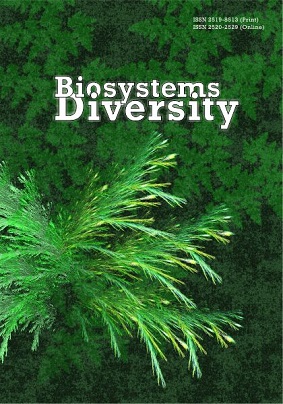Ecological-faunistic analysis of ground beetles and tiger beetles (Coleoptera: Carabidae, Cicindelidae) of metropolises of Ukraine
Ecological-faunistic analysis of ground beetles and tiger beetles (Coleoptera: Carabidae, Cicindelidae) of metropolises of Ukraine
Author(s): A.V. Putchkov, V. V. Brygadyrenko, N. Y. NikolenkoSubject(s): Agriculture, Regional Geography, Rural and urban sociology, Environmental interactions
Published by: Дніпропетровський національний університет імені Олеся Гончара
Keywords: Caraboidea; species composition; ecological structure; urban cenoses; cities;
Summary/Abstract: Ground beetles and tiger beetles are the most noticible representatives of predatory invertebrates often used in bioidentificational studies. This article provides quantitative and ecological characteristics of Caraboidea in five metroplises of Ukraine (Dnipro, Donetsk, Kharkiv, Kyiv, and Lviv). In total, in these cities, 237 species of Caraboidea were recorded, belonging to 63 genera and two families – Carabidae (231 species, 61 genera) and Cicindelidae (6 species, 2 genera). By abundance of Carabidae in megapolises, 33 species were identified to abundant. Eudominants were represented by three species: Harpalus rufipes, Pterostichus melanarius and P. оblongopunctatus, dominants – five: Amara aenea, Anchomenus dorsalis, Calathus fuscipes, Harpalus distinguendus and Poecilus versicolor. Subdominants were 25 species: Amara similata, Asaphidion flavipes, Badister bullatus, Bembidion lampros, B. properans, Broscus cephalotes, Calathus ambiguus, C. melanocephalus, Carabus cancellatus, C. coriaceus, C. granulatus, Cylindera germanica, Harpalus affinis, H. anxius, H. griseus, H. latus, H. tardus, Limodromus assimilis, Microlestes minutulus, Nebria brevicollis, Notiophilus palustris, Poecilus cupreus, Pterostichus niger, P. ovoideus and P. strenuus. In the studied cities, 53 species are rare, 151 species were identified to the group of accidental species. For separate cities, number of eudominants ranged from 4 (Donetsk, Kyiv) to 6–8 (Kharkiv, Lviv). Ten species discovered: Amara famelica, A. majuscula, Anisodactylus nemorivagus, Asaphidion pallipes, Badister lacertosus, Blemus discus, Harpalus laeviceps, Limodromus krynickii, Pterostichus minor and Tachyta nana were new for the Steppe zone of Ukraine. Chlaenius aeneocephalus and Brachinus brevicollis were recorded for the first time in the Right Bank of the northern subzone of the steppe zone, and Stenolophus abdominalis mentioned earlier for the far south of Ukraine was for the first time reported for the northern Steppe. Microlestes nеgrita was new for the Forest Steppe, and Masoreus wetterhalli and Syntomus foveatus, known earlier for the forest zone and the south of the steppe zone, were for the first time reported for its northern subzone. The levels of faunistic similarity of Caraboidea for different metropolises ranged within 0.20–0.60 for all species and 0.32–0.90 for abundant species. Most similar were carabidofaunas of Kharkiv and Dnipro (similarity index of Jaccard equaled 0.58–0.87), slightly lower in Dnipro and Kyiv (0.50–0.72). Lowest parameters were seen for Lviv compared with the other cities (0.20–0.32). According to the species composition, the most numerous were meadow (119) and forest elements (59 species). To the polytopic group, 25 species are identified, 23 to the steppe group, and 11 species to the litoral group. In numbers in all the metropolises, the polytopic group dominated, among which abundant species comprised almost half. Within the forest group in Dnipro, Donetsk and Kharkiv, 4–6 abundant species were recorded, whereas in Kyiv and Lviv their number was 14–17 species. Within the meadow group, common species were represented by 4–11 species, and in the steppe and litoral groups such species were absent. In relation to moisture, eudominants were mesophiles (165 species), including 31 abundant species. According to the trophic specialization, zoophages dominated (146 species), including 24 abundant species. Among zoophytophages, 60 species (seven abundant) were recorded. Phytozoophages were represented by 30 species (two abundant). According to mechanical composition of soil, the more diverse groups were observed to be made up species preferring loamy and clay-loamy soils (85 species each), but to the abundant species from these groups, 6 and 10 species respectively were identified. The group of ground beetles with non-manifested preferences to mechanical composition of soil was represented by 41 species, though by number of abundant (17 species), the group was dominant. To inhabitants of heavy loamy, sandy and sabulous soils, 4, 6 and 16 species correspondingly were identified, and no abundant species were observed. At the level of abundant species, the ecological structure was more similar than shown by the analysis of all the species of ground beetles. Hypothetically, typical representatives of carabid beetles of Ukrainian metropolises could be considered polytopic or meadow (to a lesser extent forest) mesophile zoophages or zoophytophages which prefer loam-clayey soils without preference to one or the other type of soil.
Journal: Biosystems Diversity
- Issue Year: 28/2020
- Issue No: 2
- Page Range: 163-174
- Page Count: 12
- Language: English

